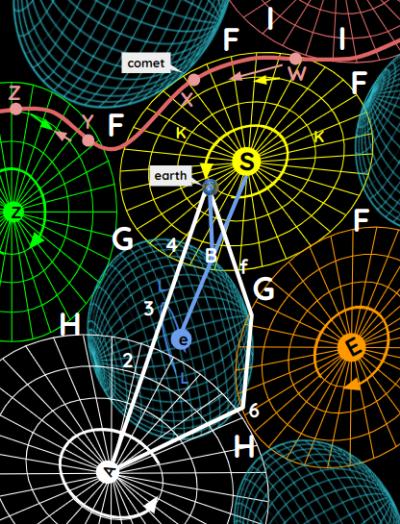Descartes' System of Astronomy
Table of Contents
Descartes was the first who tried to ascertain precisely this invisible chain that Kepler said to link the planets to the sun.
He explained that the real inertness of matter was:
- not in an aversion to motion and
- not in a propensity to rest
The real inertness of matter was in a power:
- of continuing indifferently either at rest or in motion, and
- of resisting, with a certain force, whatever tried to change its state from the one to the other
All of space was full of aether. This aether and space were the same. Consequently, there was no void.

This immense aether was divided into an infinite number of very small cubes which whirled around on their own centers to create two different elements:
- The angular parts
These were rubbed off and grinded yet smaller by their mutual friction. This was the most subtile and moveable part of the aether
- The little globules
These were formed by the rubbing off of the first. The gaps between these globules was filled up by the angular parts.
The infinite space filled with the aether caused infinite collisions which caused the little globules to be grinded down into the angular parts. This caused the angular parts to be more than enough to fill the gaps between the little globules, and became heaped up together, without any mixture of the little globules along with it.
This was the original division of the aether.
Descartes’ Law of Conservation of Energy
A certain amount of motion was originally impressed by the Creator and the laws of motion were so adjusted as always to preserve the same amount in it, without increase nor reduction.
Whatever motion was lost by one part of the aether was communicated to some other*. Whatever was acquired by one part of the aether, was derived from some other.
Superphysics Note
Thus, through an eternal revolution from rest to motion and motion to rest, the amount of motion in the whole was always the same.
But there was no void. And so a movement of one part of the aether moved another part out of its place, which led to a chain reaction.
To avoid an infinite progress, a body that pushed away the aether in front of it would have the aether roll in immediately behind it to supply the place of the aether that was displaced.
This is similar to the swimming of a fish. The water, which it pushes before it, immediately rolls backwards, to supply the place of what flows in. The water thus forms a small circle or vortex around the fish.
In the same way, the motion originally impressed by the Creator on the aether necessarily produced in it an infinity of large and small vortices, or circular streams.
The law of motion always adjusted to preserve the same amount of motion in the universe. This made those vortices either continued forever, or by their dissolution, give birth to others of the same kind.
There was, thus, at all times an infinite number of bigger and smaller vortices or circular streams revolving in the universe.
But whatever moves in a circle is constantly trying to fly off from the center of its revolution because the natural motion of all bodies is in a straight line.
All the bodies in each of those greater vortices were thus continually pressing from the center to the circumference according to their bulk and solidity.
- The larger and more solid globules of the second element forced themselves upwards to the circumference
- The smaller, more yielding, and more active particles of the first were forced downwards to the center as these could flow even through the gaps of the second
Despite their natural tendency to go to the circumference, they were forced to the center for the same reason that wood floats when plunged in water. This is because its tendency downwards is weaker than that of the particles of water which force it upwards.
But the angular parts were in excess of what was needed to fill in the gaps between the second. It necessarily accumulated in the center of each of these great circular streams, and formed there the firey and active substance of the Sun.
The Solar Systems were infinite in number. Each Fixed Star was the center of one.
Descartes is among the first of the moderns who took away the boundaries of the Universe.
- Even Copernicus and Kepler confined it within, what they supposed, the vault of the Firmament.
The center of each vortex was thus occupied by the most active and moveable parts of the aether. There was necessarily among them, a more violent agitation at the center than in any other part of the vortex which then supported the movement of the whole.